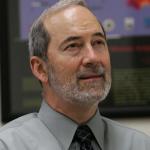Group B, Poster #240, Ground Motions
Updates to the CyberShake PSHA Platform
Poster Image:

Poster Presentation
2022 SCEC Annual Meeting, Poster #240, SCEC Contribution #12504 VIEW PDF
re. Using RSQSim, we generated a 715kyr rupture catalog for the UCERF3 fault system that includes full slip-time histories along fault planes. Building on the work in Milner et al. (2021), we performed CyberShake Study 21.12 using the RSQSim ERF to calculate the first fully-deterministic regional PSHA hazard model. We computed 26 million two-component seismograms and long-period (T≥2 sec) CyberShake-RSQSim hazard curves for 335 sites in Southern California. We then modified the RSQSim frictional parameters to mimic a velocity strengthening layer in the upper 3 km, generated a new 240kyr catalog, and used this catalog to perform an additional study, 21.12b. We present results from these studies and comparisons with empirical ergodic ground motion models (GMMs) and CyberShake Study 15.4, which used the UCERF2 ERF in the same region.
Additionally, we have extended CyberShake using modules from the SCEC Broadband Platform (BBP) to generate broadband ground motions up to 50 Hz to include a broader range of frequencies of engineering interest. Broadband CyberShake has undergone extensive verification and validation testing using both BBP simulations and data from historical earthquakes, including Northridge, Chino Hills, Whittier, and Landers. For each historical event, we used Broadband CyberShake to generate ground motions by combining results from low-frequency (≤1 Hz) deterministic finite difference wave propagation in 3D media with stochastic high-frequency seismograms (1-50 Hz), for multiple slip realizations and stations. We compared Broadband CyberShake, BBP, and GMM ground motions against observed data, and found that goodness-of-fit results from Broadband CyberShake realizations do as well as or better than the other models in matching the data from historical events.
SHOW MORE
Additionally, we have extended CyberShake using modules from the SCEC Broadband Platform (BBP) to generate broadband ground motions up to 50 Hz to include a broader range of frequencies of engineering interest. Broadband CyberShake has undergone extensive verification and validation testing using both BBP simulations and data from historical earthquakes, including Northridge, Chino Hills, Whittier, and Landers. For each historical event, we used Broadband CyberShake to generate ground motions by combining results from low-frequency (≤1 Hz) deterministic finite difference wave propagation in 3D media with stochastic high-frequency seismograms (1-50 Hz), for multiple slip realizations and stations. We compared Broadband CyberShake, BBP, and GMM ground motions against observed data, and found that goodness-of-fit results from Broadband CyberShake realizations do as well as or better than the other models in matching the data from historical events.
SHOW MORE





































































